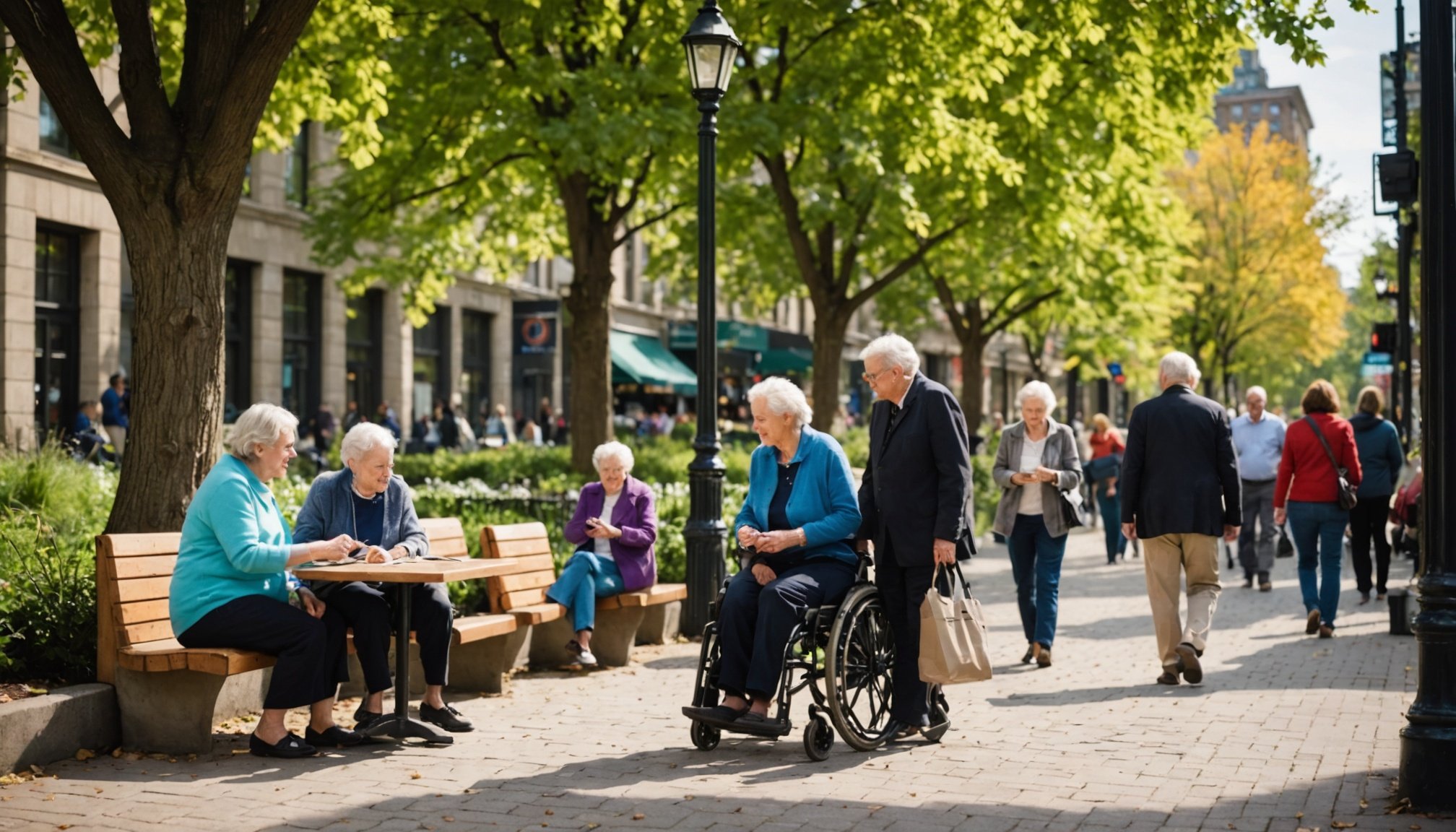Understanding Age-Inclusive Design Principles
Age-inclusive design is a crucial consideration in urban planning. It ensures urban environments are accessible to individuals of all ages, with a focus on the needs of seniors. At its core, this design philosophy acknowledges the diverse abilities and requirements of the aging population, promoting accessibility and equality.
Key principles in age-inclusive design include physical accessibility, social inclusivity, and safety. Creating environments that are easy to navigate, with features like ramps and tactile paving, ensures seniors can move freely and safely. Additionally, urban spaces should foster social connections, with parks and communal areas designed to encourage interaction and engagement.
This might interest you : Key Elements for Developing Cost-Effective Housing Solutions in Densely Populated Cities
The benefits of age-inclusive urban spaces extend beyond seniors. Such designs can enhance the quality of life for the broader community. Parents with strollers and people with temporary disabilities can also enjoy safer and more convenient environments. Moreover, businesses within these spaces are often more accessible, leading to increased economic activity.
By focusing on age-inclusive design, urban planners create not only senior-friendly environments but also more inviting and practical spaces for everyone. This approach fosters a sense of belonging and community while addressing the unique challenges faced by the aging population.
In parallel : Maximizing Savings: Discover the Financial Perks of Adopting Green Building Standards in City Development
Accessibility Features for Senior-Friendly Spaces
Creating urban environments that are accessible to seniors is essential for age-inclusive design. It ensures that all individuals, irrespective of their age or abilities, can navigate spaces safely and independently. To achieve this, focusing on particular accessibility features is paramount.
Walkways and Paths
Walkways should be wide, smooth, and well-maintained to allow easy movement for seniors, including those using mobility aids. Features like ramps, handrails, and tactile paving are crucial for enhancing accessibility. Adequate seating areas along walkways also provide necessary rest points.
Public Transport Options
Reliable and accessible public transportation is vital for maintaining seniors’ independence. Low-floor buses and priority seating are examples of adjustments that can make transport systems more inclusive. Additionally, clear signage and audible announcements contribute to a more senior-friendly experience.
Building Access and Entrances
Buildings should prioritize adaptive features that cater to mobility challenges. Automatic doors, elevators with clear signage, and non-slip flooring all contribute to safer and more accessible entrances. Such features not only invite seniors but also enhance overall urban accessibility for a diverse community.
By integrating these elements, urban planners can substantially increase the usability of public spaces, fostering a more inclusive society for everyone.
Enhancing Safety in Urban Environments
Ensuring safety measures in urban areas is essential, particularly for seniors, who may feel vulnerable in bustling environments. One critical aspect is crime prevention through environmental design (CPTED), which strategically employs urban safety principles to reduce crime opportunities. This includes designing open, well-organized spaces that minimize hiding spots and encourage natural surveillance.
Effective urban lighting is crucial in boosting safety. Bright and strategically placed lighting enhances visibility, enabling residents and seniors to feel secure even after dusk. This approach also includes the use of motion-activated lights and illuminated pathways, further deterring criminal activity.
Additionally, incorporating safety features like emergency call points and clear signage can significantly improve the sense of security. These features are particularly beneficial in large parks or urban plazas where seniors frequently gather.
Urban planners must focus on community-friendly designs that account for both physical safety and a senior-friendly atmosphere. By prioritizing these safety measures, cities can cultivate inclusive spaces that reassure and welcome all citizens, regardless of age. Prioritizing urban safety not only benefits seniors but the entire community, making public areas more inviting and vibrant places to live and interact.
Promoting Social Interaction in Urban Spaces
Incorporating social interaction elements into urban spaces plays a pivotal role in fostering community engagement. This approach enhances public spaces, making them inviting environments for seniors and individuals of all ages to connect and share experiences.
Shared Spaces for Community Engagement
Urban planners should focus on creating shared spaces like parks and communal squares. These areas should accommodate a variety of social activities and provide ample seating, shade, and other amenities. Designing such environments encourages spontaneous gatherings and strengthens community ties.
Social Programs and Activities
Implementing social programs specifically designed for seniors can foster connections and break the cycle of isolation. Activities such as gardening clubs, art classes, and group exercises offer opportunities for interaction and skill-sharing. These programs not only engage seniors but also promote a sense of belonging.
Designing for Interaction
Well-thought-out design elements can significantly enhance social interaction. Integrating benches, shaded areas, and pathways that lead to focal points can naturally encourage people to gather. Designing spaces with soft boundaries allows for flexible usage, adapting to both individual and group needs. By focusing on these elements, urban areas can evolve into vibrant hubs that nurture community relationships and cater to seniors’ social needs.
Innovative Ideas for Senior-Friendly Public Spaces
Urban environments are evolving with innovative design strategies that cater to senior spaces. Best practices incorporate technology for enhanced urban innovation, improving accessibility and comfort for seniors. One approach involves installing smart street furniture equipped with sensors. These can provide real-time information about seating availability and nearby amenities, making public areas more senior-friendly.
Another exemplary design is the use of adaptive technology in public transport systems. Such innovations include interactive touchscreens and digital maps that offer accessible navigation options tailored to seniors’ needs. Cities like Singapore are leading in these efforts, integrating technology into urban design to boost accessibility.
Additionally, successful designs often incorporate nature-based solutions for creating therapeutic environments. Green roofs, urban gardens, and nature trails not only provide aesthetic appeal but also promote physical and mental well-being for the elderly. Communities benefit significantly from these nature-infused designs, which encourage outdoor activities and reduce stress.
By fostering inclusive and tech-enhanced public spaces, cities not only support their aging populations but also set benchmarks for urban innovation. These advances pave the way for age-inclusive designs that benefit all age groups, creating vibrant and interconnected urban environments.
Involving the Community in the Design Process
Incorporating community involvement in the design process is a cornerstone of successful age-inclusive urban spaces. Leveraging participatory design ensures that environments truly reflect the needs and desires of those who use them, enhancing satisfaction and functionality. Stakeholder engagement fosters collaboration between planners and residents.
Engaging Local Residents
To make design processes more democratic, urban planners can organise workshops and public forums, where local residents, especially seniors and their families, can voice their opinions. These sessions provide invaluable insights into the daily challenges faced by the community, ensuring that urban spaces are genuinely inclusive and accessible.
Collaborating with Organizations
Partnerships with local organisations and advocacy groups offer additional expertise and resources. By collaborating actively, planners can understand existing gaps and leverage these relationships to foster innovative solutions tailored to diverse community needs.
Feedback Mechanisms
Establishing robust feedback mechanisms is vital for assessing the effectiveness of age-inclusive designs. Implementing regular surveys, suggestion boxes, and open discussions allow continuous improvement. These feedback loops facilitate adjustments and enhancements, ensuring urban environments remain accommodating and enjoyable for all residents.
Community input and active participation transform urban spaces, making them dynamic and responsive to evolving needs. Through this inclusive approach, cities cultivate environments where every citizen feels valued and respected.
Policy Considerations for Age-Inclusive Urban Spaces
Urban policymakers must address key considerations to ensure age-inclusive spaces. Important urban policy frameworks support designs facilitating accessibility and social engagement across all ages. These policies encourage the development of environments where seniors and the broader community can thrive.
Inclusivity policy is crucial, mandating features that accommodate various physical and cognitive abilities. Such policies often require ramps, accessible public transportation, and safe pedestrian pathways within urban planning. This regulatory focus promotes environments that remain accessible to those with limited mobility or specific needs.
Planning regulations play a vital role in shaping urban landscapes. Zoning laws must encourage mixed-use developments, ensuring that essential services like healthcare, shopping, and social amenities are easily accessible to senior residents. These regulations support the creation of vibrant neighborhoods that cater to diverse demographic needs.
Policy advocacy and community efforts can significantly influence legislative processes, encouraging reform that prioritizes inclusivity. By actively engaging with local governments, advocacy groups can push for necessary policy changes, ensuring age-inclusive urban development. These collaborative efforts create more welcoming cities that benefit everyone, fostering accessibility and inclusivity through thoughtful urban policies.





